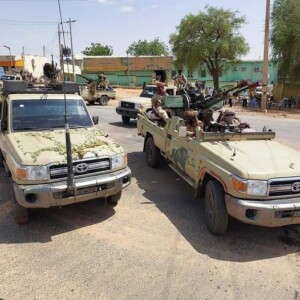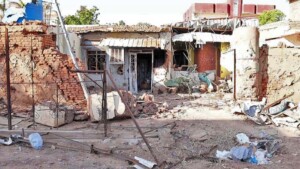Sudan Lawyers: ‘Slain protester shot in head then run over’
The Sudanese Emergency Lawyers stated that the autopsy report following the death of protester Gasim Abdelwahab (19) on Tuesday’s March of the Millions proves that he was killed by gunshot wounds to the head and chest before being run over by a military vehicle.
 Slain protester Gasim Abdelwahab (Photo: social media)
Slain protester Gasim Abdelwahab (Photo: social media)
The Sudanese Emergency Lawyers stated that the autopsy report following the death of protester Gasim Abdelwahab (19) on Tuesday’s March of the Millions proves that he was killed by gunshot wounds to the head and chest before being run over by a military vehicle.
Samir Sheikh Idris, a member of the Emergency Lawyers, told Radio Dabanga that the autopsy report also indicated that Abdelwahab’s body was run over by a military vehicle. Car tire track marks were found on his chest.
The slain protester’s body was handed over to his family and buried in Khartoum’s Bakri Cemetery, Idris said.
The Emergency Lawyers also monitored other widespread violations against peaceful demonstrators during the March of the Millions which marked the anniversary of the coup d’état of October 25, 2021.
According to the lawyers, more than 100 demonstrators were injured and taken to various hospitals across the capital. The regular forces also took 47 people to the Northern Police Station in Khartoum, the lawyers stated.
The Port Sudan Resistance Committees also stated that 22 protesters were detained during their demos.
‘Sabotage’
In a statement by the Head of the Sudanese Police Force, pro-democracy protesters were described as “trained forces with armed military formations, that espouse violence and sabotage”.
The Khartoum Resistance Committees issued a statement in response, saying that the police forces had a habit of “fabricating stories about peaceful protests in order to legitimise shameful acts against them”.
The committee statement went called on national and international human rights agencies to “monitor and document violations by the Sudanese Police Forces against peaceful protesters and activists”.
The police statement also provoked widespread condemnation from jurists, politicians, and journalists who considered the statement a threat to use more violence.
Emergency Lawyer Idris described the statement as “bearing a new tone in dealing with the popular movement” in his interview with Radio Dabanga.
Idris said the statement “foreshadowed the development of more violent mechanisms” and seemed like a request for carte blanche in “taking legal measures against the demonstrators”.
The Forces for Freedom and Change (FFC) also saw the police statement as a threat to demonstrators and an “attempt to obtain decisions from the authority to raise the level of violence and impunity”, according to their executive office.
The FFC renewed their position, saying that they were in “complete rejection of the coup” and sought to “bring it down and end its authority through mass pressure”.
Omar El Degeir, head of the Sudanese Congress Party, described the police statement as a “miserable comic rhetoric that evades facts and lacks coherence”.
He explained, in a post on his Facebook page, that the police did not care about the death of the Abdelwahab and protesters who were injured as a result of their “excessive repression”.
El Degeir stated that the "extraordinary measures" eluded to in police statement would allow the authorities to “practice more bloody repression”.
In an interview with Radio Dabanga, elected chair of the Sudanese Journalists Syndicate, Abdelmunim Abu Idris, stated that the language used in the police statement is a “paradox of logic” which threatens to “target journalists with repression in any upcoming demonstration”.
He added that the police are seeking to spread fear and confuse the scene and increase violence even more towards the demonstrations in the coming period.
October 25 anniversary protests
Hundreds of thousands of Sudanese took to the streets across nine states yesterday, to mark the anniversary of the dawn coup d’état of October 25 last year. In marches across the country, protesters demanded the overthrow of the military junta, and a return to democracy and civilian rule. Marchers were met with fierce resistance from Sudan’s security forces. Many more injured as tear gas and stun grenades were used against peaceful protesters.
In measures to pre-empt the marches, authorities in Khartoum cut off internet services for mobile phones on Tuesday morning and closed a number of main roads, as well as all bridges linking the capital with Omdurman and Khartoum North (Bahri), except for the Soba and Halfaya bridges.
Protesters gathered at more than 20 muster points with the aim to converge on the Republican Palace in central Khartoum. Large numbers of military personnel were deployed along the anticipated paths of the processions.
Most of the schools in Khartoum closed their doors without an official decision from the state government, while most government and private facilities stopped working on Tuesday in anticipation of the demonstrations.
The marchers were met with volleys of tear gas and stun grenades. In Khartoum, the marches reached El Gasr Street, despite the tight security barriers, but they retreated due to the excessive resistance. However, the security forces impeded the arrival of the demonstrators from Khartoum Bahri and Omdurman by using excessive violence and closing bridges with containers. The Khartoum Bahri Neighbourhood Committees called for a complete closure of the city, calling on the revolutionaries to occupy the streets.











 and then
and then